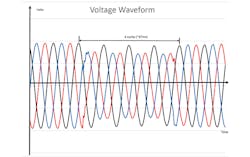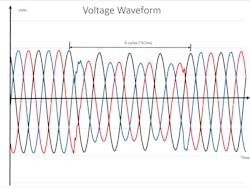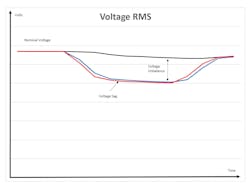PQ Events on the Utility Side of the Meter
The figures contained in this article show how the voltage level in a facility was affected by a fault condition that occurred on an electric utility feeder that is adjacent to the utility feeder serving the facility. The unexpected disturbance resulted in a voltage unbalance on the facility’s 3-phase electrical system, as well as voltage distortion and a sag on two of the three phases.
Figure 1 shows the voltage waveform, and Fig. 2 shows the RMS representation of the waveform. The voltage dipped lower than 90% of nominal and the voltage unbalance was greater than 10%.
Is it possible for a facility’s electrical equipment to be that sensitive to these types of events?
The answer lies in the type of equipment that’s installed in the facility. Electronics that are protected behind a well-maintained uninterruptible power supply (UPS) system can ride through most of these events unnoticed. The UPS system is designed to protect against voltage distortions, unbalances, sags, and other disturbances.
But what is shown in these figures is only half the story. What happened after the disturbance was cleared?
Large electrical motors that are line connected and operating during a voltage unbalance or sag will briefly become a generator. Once the line voltages recover to nominal, the voltages generated by the motor/generator cause the line voltages to swell. Any electrical equipment at the facility that is not protected by a UPS system is then subjected to overvoltages caused by this brief interaction.
To avoid this overvoltage or swell, consider installing a motor drive. The internal electronics of the drive will create a buffer between the line voltage and motor. Another consideration is to evaluate different types of electronic motor protection devices that disable the motor when it detects these types of events.


